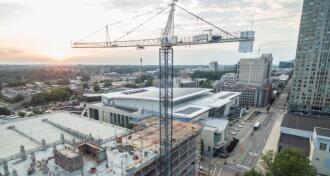This article is part of a series summarizing key topics discussed at Ward and Smith's 2021 Construction Conversations Webinar.
Recently, Hank Harris, Ward and Smith Business Consulting Director of Consulting, delivered his take on the factors currently shaping the construction industry and what he anticipates the future will bring.
Harris spent most of his career in a national management consulting and investment banking firm, where he specialized in working with privately-held businesses. Having worked closely with hundreds of successful business owners over the years, Harris possesses a nuanced understanding of the issues most important to entrepreneurs and privately held businesses.
“When you talk about the future, one thing’s for sure, and that is you’re going to be wrong,” said Harris, “because it’s impossible for any of us to really know what is going to happen.”
Harris began the discussion with an analysis of the projections he made last year, starting with a few largely accurate predictions and then detailing a few unanticipated changes. Some of his ideas from 2020 that materialized this year included:
- The $1 trillion infrastructure bill,
- Substantial federal stimulus
- Vaccine rollout in the first quarter, and
- The largely ‘V-shaped’ economic recovery.
Harris also mentioned several unexpected developments in 2021, including:
- Persistent supply chain issues,
- Continuity of COVID, and
- Asset pricing frenzy with cars and housing.
“Most construction companies had a record year in 2020,” said Harris, “which is really kind of amazing given what everyone was going through.” He explained that construction spending in 2020, despite Covid, was up five percent.
For the most part, backlogs were down at the start of this year. This was a cause of concern for many of the leaders in the construction industry, said Harris. Since then, backlogs have been rebuilding and are now at a mostly higher level than in 2020.
“Confidence levels as reported from surveys of CEOs and leaders of construction companies are at very high levels,” said Harris. “Right now, there is a lot of optimism. The Compound Annual Growth Rate (CAGR) for the industry won’t be that big for this year, only up to around two percent, but once you go beyond that, the prognosis is around 4.7 percent for the next four years.”
Harris believes the rollout of the infrastructure bill will have positive implications for the construction industry over the next five years, as the spending package will include:
- $110 billion on roads and bridges
- $66 billion on railroads
- $65 billion in broadband internet access
- $73 billion on the power grid
- $21 billion environmental
Also, there will be an uptick of interest related to heavy highways and heavy civil, such as has not been witnessed by industry insiders for many years. “Private equity has typically not been very attracted to that sector, but that’s changing,” Harris commented. “There’s just a lot of capital chasing very few opportunities right now.”
Continuing Trends
There are many factors that Harris believes will have relevance to the construction industry moving forward. He expects that the war for talent will rage on, given the industry need, the labor market, and the housing demand.
Harris predicts that the implementation of advanced technology into the construction industry is going to continue to increase: “Technology adoption in construction is at an all-time high, and that’s not going to change. Construction will always need people to do something, but we are seeing technology right now that nobody would have even dreamed about ten years ago.”
Succession planning for management will have significant implications for business continuity, largely driven by the size of the Baby Boomer generation. “It will take a long time for this bubble of the population to transition its businesses to the next generation,” said Harris. “This is partially because everyone has different goals and objectives; some want to sell and retire at 45; some don’t want to exit until they’re 80 plus.”
The issue of cash management will also remain important. With the construction industry as hot as it is right now, companies are witnessing substantial growth; however, this can be dangerous if the flow of capital is not managed effectively.
Harris pointed out that, “It might be counterintuitive to some people, but there are plenty of profitable companies that end up going broke because they run out of cash.” Some essential items to consider when managing a balance sheet include figuring out how much long-term debt is good to have versus short-term debt, managing unbilled work in process, and arranging all the pieces in the cash flow puzzle to make sure the business is safe.
According to Harris, another issue that is top of mind for many contractors is how to remedy the concerns of the banks/bonding companies. To alleviate their concerns, he recommends creating an effective process for managing cash flow.
Looking Ahead
Moving forward, company leaders understand their current strategy and vision for the future. “What is going on right now is not going to last forever. We think the trends are good for the next five years, but nobody really knows,” notes Harris. “Every company, regardless of size, has a leader, and that individual has to make sure that the company is looking around the next corner and thinking about what could happen.”
For Harris, there is a Goldilocks-level of growth for the construction industry: “I think a CAGR for a contractor that is between 10 and 15 percent is probably not a bad thing, especially when the market will allow for it. When it gets much higher than that, you court a lot of problems. It’s likely going to strain your working capital, and I know it’s going to strain your people, and those two things alone make it a highly questionable business practice.”
To figure out a direction for sustainable growth, Harris advises business leaders to first serve existing clients, as that is the safest bet. If providing services to an existing client base does not offer enough growth opportunities, the next logical step is to migrate to different geographic areas or vertical markets. Diversification could offer another potential avenue for growth; seeking out new business with new people would have a higher risk profile, says Harris.
In the next five years, Harris predicts the hottest areas of economic expansion will be in:
- Manufacturing - A reshoring of jobs will take place due to supply chain issues
- Heavy civil
- Healthcare - Because of the aging population
- Education - Current facilities are insufficient
- Environmental
Strategic Planning Horizon
Harris thinks an offensive business strategy makes sound financial sense over the short term. In the intermediate term, business leaders should incorporate a blend of both the offensive and defensive. Developing a strategy for navigating future market conditions is also critical, Harris explained.
However, Harris believes that a market downturn is predictable in that it’s a certainty; predicting when it will happen is a trickier proposition. He commented that: “My theory about what will cause the next recession is that private assets are overvalued across the board. This is somehow going to coincide with the mass realization that the government has gone overboard in terms of debt and spending.”
To manage risk, Harris encourages business leaders to keep risk factors in mind and consider backing away from a project if the answer is ‘No’ to more than one of the questions below:
- Do we have a team that can do this?
- Do we have experience with this type of project?
- Do we know this client?
- Is there anything in the contract we are not accustomed to?
- Have we worked in this geography before?
“In summary, these have been good times, relatively speaking, but it’s important for business leaders to manage their operations carefully and keep an eye on what the future will bring,” added Harris.








